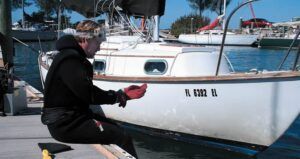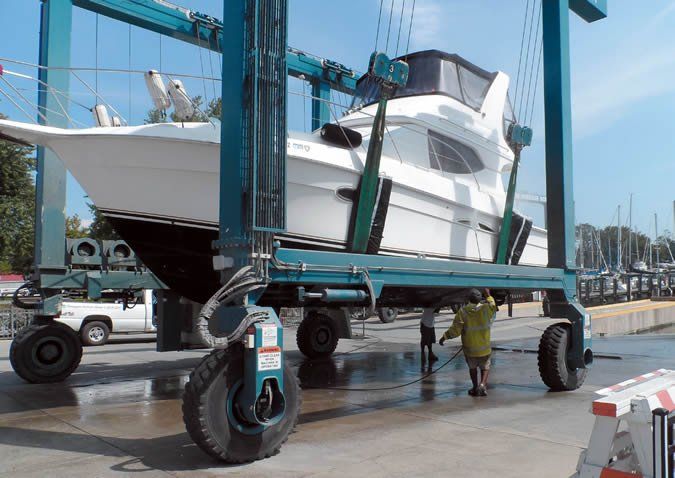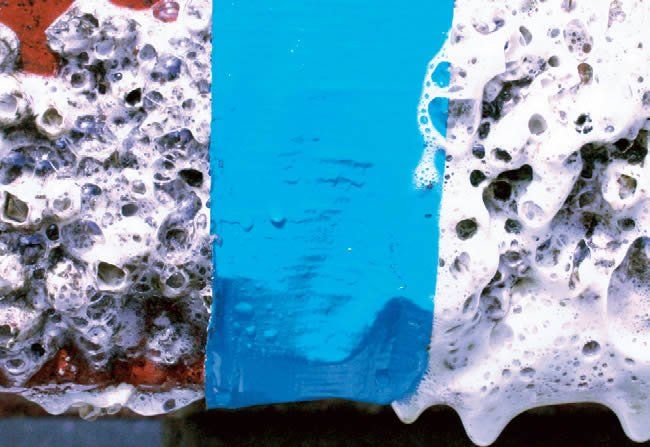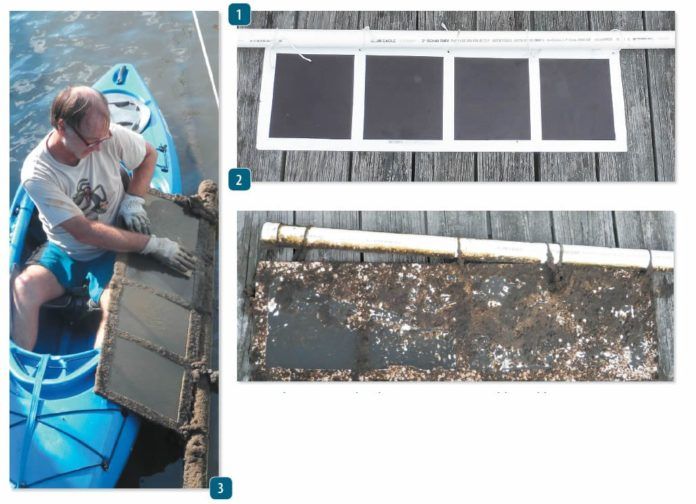Modern anti-fouling paints promise a hull free of marine growth for one to several seasons. But in nutrient-rich water and as the paint becomes expended, barnacles and green stuff take hold, slowing us down, increasing fuel consumption under power, and degrading handling.
For all of the money spent on special props and new sails, and attention paid to perfect sail trim, no single factor is more important than a clean bottom. To combat this, racers use hard, scrubbable paints and scrub the bottom every two weeks.
If a cruiser with soft paint followed that rhythm, his paint would be dispersed far and wide within a few months (see adjacent article on Cleaning Soft Paints). For these and other reasons, different methods are required.

Finally, even going slow and wasting fuel means nothing to you, clogged through hulls can cripple vital systems and vibration from a fouled prop can damage the powertrain. Sooner or later, the bottom will need to be cleaned, either by haul-out, or by in-water scrubbing.
CLEANING SOFT PAINT
Soft (aka ablative or self-polishing) paints hold the promise of self cleaning, but this is primarily true only for boats that are vigorously sailed (routinely over 7 knots), the minimum required to cause a little surface wastage. Even then, in high fouling waters and towards the end of the useful life of the paint, growth begins to appear. But we don’t want to scrub the paint off, wasting money and releasing excess copper into the environment.
Additionally, our experience with multi-season soft paints is that if they are extended to maximum life with occasional scrubbing toward the end, followed by moderate sanding between applications, build-up and adhesion problems are minimized, and stripping can be delayed for 30 years or more. But this requires really using up the paint. Yes, cleaning may release some copper, but by stretching painting from 2 years to 3 years, have we not reduced the amount of copper released by 1/3? This is one time when the motivations of the EPA and the parsimonious boat owner should be aligned.
WHAT WE TESTED
We painted panels with West Marine PCA Gold, a copper-based multi-season paint containing 40 percent copper. Private labeled by Petite, it is representative of the market and a perennial top performer in PS testing. We cleaned these panels following the schedule described above, noting how the paint held up over time. The panels were deployed in a marina in the mid-Chesapeake Bay, right next to our test boat, which was not cleaned, but unlike the panels, was sailed every two weeks. Sailing speeds range from at least some time over 7 knots on every trip, to 10-14 knots on windy days.
HOW WE TESTED
We cleaned fiberglass test panels according to the following schedule:
Panel 1. Lightly cleaned with a glove whenever heavy slime appeared.
Panel 2. Light cleaning with Berber carpet square when measurable plant growth appeared.
Panel 3. Cleaning with scraper and carpet when barnacles or heavy growth appeared.
Panel 4. No cleaning.

OBSERVATIONS
The panels went in the water in September. No cleaning was performed on any panel for the first 10 months. There was zero fouling or slime. The first two panels were cleaned of light fouling several times near the one-year mark, but this was hardly needed, because approaching near-freezing winter water temperatures knocks off all soft growth. No growth was observed until April. Cleaning resumed in late May.
As the second year progressed, paints wore thin and began to chip off during cleaning, and sometimes spontaneously. Bottom paint adhesion was not the problem, the paint was simply wearing through.
In late summer the second year we then stopped cleaning the panels, to observe how much fouling resistance remained. The panels that had been cleaned rapidly fouled with plant growth and barnacles. The panel we had never cleaned had slime and a few scattered barnacles, but much fewer than panels that had been cleaned just two months before.

RESULTS
Panel 1. Cleaned with rubber glove. Even a rubber glove work glove removes paint, although it was clearly the gentlest method. No paint plume was visible. That said, by month 20 the paint was worn thin. We had cleaned far more often than most sailors would. For the racer we recommend hard paint, but if you must clean, this is the method of choice. The occasional barnacle should be popped off using your thumb, not a scraper. For the cruiser, an occasional hand wipe of only the fouled spots may be acceptable.
Bottom Line: Start with this, and only where needed.
Panel 2. Cleaned with Berber carpet. Anything more than the lightest touch resulted in a black plume of removed paint. The only reason this method outperformed the glove is that we only cleaned a few times.
Bottom line: Not for soft paints.
Panel 3. Cleaned with scraper and pad. Although we only cleaned once, we couldnt help but remove paint and degrade the antifouling properties.
Bottom line: If you need to use a scraper its time for hauling and fresh paint.
Panel 4. No cleaning. It was no surprise that the boat stayed a little cleaner than this panel, since regular sailing removes loose growth off with little wear. The boat did get more growth in high-wear areas (leading edge of keel, rudder, and bow), presumably because paint wore away, even though those areas received three coats (the balance of the boat had two coats). This demonstrates just how delicate soft paints are.
Bottom line: Clean your bottom by sailing more.
IN-WATER, WITHOUT DIVING
If only it were as simple as scrubbing a pot in the sink. Methods vary with the type of paint and nature of fouling (see Cleaning Soft Paint sidebar). There are safety concerns that go beyond whether you can swim, practical matters that help speed and simplify the job, and inspection points you ought to consider while you’re down there. Every year it gets easier, even as we age, because we’ve learned efficient ways.
On-Land Cleaning. Most marinas offer powerwash and scrape as a mandatory part of haul out services. Their EPA stormwater permit requires them to control pollutants from bottom cleaning, and that means a pad with a treatment system. Normally it’s a good value, adding only slightly to the haulout fee. However, if for some reason you have to do some of this on your own . . .
Protect the ground. You must recover the paint chips and any chemicals used.
Clean while the boat is still wet. This makes the work ten times easier. Re-wetting is not the same for some reason.
Strong acids loosen barnacles. However, if the concern is only the circles they leave, sanding will remove them faster and more easily. Be aware that acids can deactivate the bottom paint, so after cleaning you will need to rinse, sand, and re-paint. Acid is the only practical way to remove barnacles from an inflatable. Rough scraping and power washing are definitely out.
SCRUBBING FROM DECK OR DOCK
Scrubbing from above calls for special brushes. Here are a few options:
The Goby. A bent handle system with an articulated head and scrubbing pads. $199.00-$229.00. www.chptmfg.com
The Scrubbis uses a unique float/squeegee combination to remove slime. $109.00 www.scrubbis.se/
Shurhold deck brushes are common enough. Add a bent handle extension and an articulating head for scrub pads, and you have a simple touch-up tool. There are also extensions, though they are not bent far enough to get under the hull. About $60- $90 for all components. www.shurhold.com.
Bent handle scrubbers provide some level of scrubbing capability without entering the water. If you use hard paint and only need to remove light slime before a race, and you have finger docks on both sides of the boat, these will help.
However, you won’t be able to clean the prop—perhaps the most important square foot on the boat—or poke-out the through hulls. Brushes don’t remove significant soft growth, they can quickly scrub away too much soft paint, and they are useless against barnacles. Cleaning the critical keel and rudder areas is difficult to impossible from the deck. Without a walkway on both sides of the boat, the results are poor. Finally, you can’t reach most of a multihull, since access is blocked by the bridge deck and trampolines.
CONCLUSION
The best way to clean soft paint is aggressive sailing. Not just a Saturday drifter. Go out and really hammer the boat once in a while, even if it’s just motoring fast. You will still need to go in the water once in a while to check on your through-hulls and clean the prop. While you are at it, there is no harm in wiping a few bad spots and popping off a few barnacles. But if stretching the life of the paint and protecting the environment matter to you, leave the scraper and pads in the tool box until the very end, and even then use these with discretion. This a case in which less is definitely more.





































Good article. I’d be interested in learning about the cost differences between a hard paint cleaned in-water monthly vs a soft paint seldom cleaned by a diver but hauled and repainted annually.
Also, I’ve alway been curious if the bottom of a boat with a soft paint that has completely failed can merely be put on a more frequent dive cleaning schedule rather than haul it out and renew? Does this have any deleterious effect on the gelcoat and/or hull?
GREAT QUESTIONS! I hope PS responds.
I don’t know about this. I use Micron CSC (ablative), and by mid-August in Buzzards Bay, the bottom is completely covered in slime and more than a few barnacles and other things. I typically re-coat every other year. There is no way I could get away with not scrubbing at least once – often twice – a season.
“Vigorously sailed…at more than 7kt”–does this mean my Precision 21, with a Gerr hull speed of about 6.6kt with crew and gear, shouldn’t benefit from ablative paint? FWIW, it seems to do fine with Micron Extra in an algae-rich lake. Note that the “Extra” in the product name refers to the inclusion of slime-specific biocides. To Peter Newton in Buzzards Bay — on your next pullout, try overcoating at least part of your Micron CSC with Extra, and see if it reduces the slime problem.